
Clark Kerr was an American economist and academic administrator. He was the first chancellor of the University of California, Berkeley, and twelfth president of the University of California.
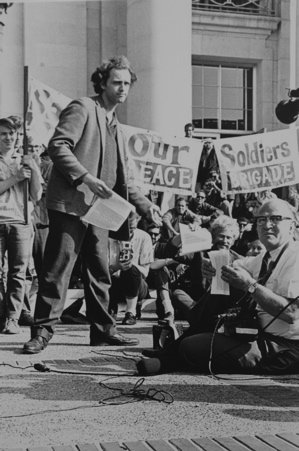
Mario Savio was an American activist and a key member of the Berkeley Free Speech Movement. He is most famous for his passionate speeches, especially the "Bodies Upon the Gears" address given at Sproul Hall, University of California, Berkeley on December 2, 1964.
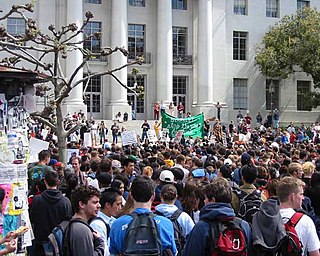
Sproul Plaza is one center of student activity at the University of California, Berkeley. It is divided into two sections: Upper Sproul and Lower Sproul. They are vertically separated by twelve feet (3.7 m) and linked by a set of stairs.
Lenni Brenner, formerly known as Leonard Glaser or Lenny Glaser, is an American Trotskyist writer. In the 1960s, Brenner was a prominent civil rights movement activist and vocal opponent of the Vietnam War. Since the 1980s, his activism has focused on anti-Zionism. He has published widely on the history of Zionism, in particular asserting that the movement collaborated with the Nazis.

Opposition to United States involvement in the Vietnam War began with demonstrations in 1965 against the escalating role of the United States in the Vietnam War and grew into a broad social movement over the ensuing several years. This movement informed and helped shape the vigorous and polarizing debate, primarily in the United States, during the second half of the 1960s and early 1970s on how to end the Vietnam War.

The protests of 1968 comprised a worldwide escalation of social conflicts, which were predominantly characterized by the rise of left-wing politics, anti-war sentiment, civil rights urgency, youth counterculture within the silent and baby boomer generations, and popular rebellions against state militaries and bureaucracies.
The Vietnam Day Committee (VDC) was a coalition of left-wing political groups, student groups, labour organizations, and pacifist religions in the United States of America that opposed the Vietnam War during the counterculture era. It was formed in Berkeley, California in the spring of 1965 by activist Jerry Rubin, and was active through the majority of the Vietnam war, organizing several rallies and marches in California as well as coordinating and sponsoring nationwide protests.
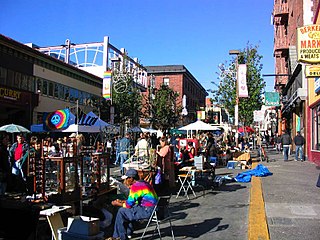
Southside, also known by the older names South of Campus or South Campus, is a neighborhood in Berkeley, California. Southside is located directly south of and adjacent to the University of California, Berkeley campus. Because of the large student presence in the neighborhood, proximity to Sproul Plaza, and history of the area, Southside is the neighborhood most closely associated with the university.
SLATE, a pioneer organization of the New Left and precursor of the Free Speech Movement and formative counterculture era, was a campus political party at the University of California, Berkeley from 1958 to 1966.
The history of the University of California, Berkeley begins on October 13, 1849, with the adoption of the Constitution of California, which provided for the creation of a public university. On Charter Day, March 23, 1868, the signing of the Organic Act established the University of California, with the new institution inheriting the land and facilities of the private College of California and the federal funding eligibility of a public agricultural, mining, and mechanical arts college.
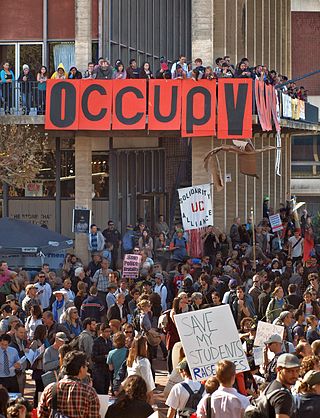
Occupy Cal included a series of demonstrations that began on November 9, 2011, on the University of California, Berkeley campus in Berkeley, California. It was allied with the Occupy Wall Street movement in New York City, San Francisco Bay Area Occupy groups such as Occupy Oakland, Occupy Berkeley, and Occupy San Francisco, and other public California universities. "Cal" in the name "Occupy Cal" is the nickname of the Berkeley campus and generally refers specifically to UC Berkeley.

The Free Speech Movement (FSM) was a massive, long-lasting student protest which took place during the 1964–65 academic year on the campus of the University of California, Berkeley. The Movement was informally under the central leadership of Berkeley graduate student Mario Savio. Other student leaders include Jack Weinberg, Tom Miller, Michael Rossman, George Barton, Brian Turner, Bettina Aptheker, Steve Weissman, Michael Teal, Art Goldberg, Jackie Goldberg and others.
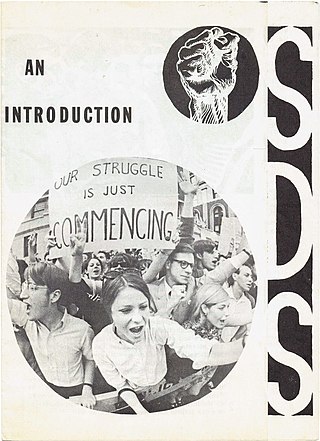
Students for a Democratic Society (SDS) was a national student activist organization in the United States during the 1960s and was one of the principal representations of the New Left. Disdaining permanent leaders, hierarchical relationships and parliamentary procedure, the founders conceived of the organization as a broad exercise in "participatory democracy". From its launch in 1960 it grew rapidly in the course of the tumultuous decade with over 300 campus chapters and 30,000 supporters recorded nationwide by its last national convention in 1969. The organization splintered at that convention amidst rivalry between factions seeking to impose national leadership and direction, and disputing "revolutionary" positions on, among other issues, the Vietnam War and Black Power.
The New Left was a broad political movement that emerged from the counterculture of the 1960s and continued through the 1970s. It consisted of activists in the Western world who campaigned for a broad range of social issues such as feminism, gay rights, drug policy reforms and the rejection of traditional family values, social order, and gender roles. The New Left differs from the traditional left in that it tended to acknowledge the struggle for various forms of social justice, whereas previous movements prioritized explicitly economic goals. However, many have used the term "New Left" to describe an evolution, continuation, and revitalization of traditional leftist goals.

Students for Justice in Palestine is a pro-Palestinian college student activism organization in the United States, Canada and New Zealand. It has campaigned for boycott and divestment against corporations that deal with Israel and organized events about Israel's human rights violations. In 2011, The New York Times reported that "S.J.P., founded in 2001 at the University of California, Berkeley, has become the leading pro-Palestinian voice on campus."

Jack Weinberg is an American environmental activist and former New Left activist who is best known for his role in the Free Speech Movement at the University of California, Berkeley in 1964.

The 2017 Berkeley protests were a series of protests and clashes between organized groups that occurred in the city of Berkeley, California, in the vicinity of the University of California campus. Violence occurred predominantly between protesters opposed to then-President Donald Trump, including activists such as antifa groups and socialists; and pro-Trump groups such as Republicans, members of the alt-lite and alt-right, neo-Nazis, and white nationalists. The majority of the participants were peaceful.
Alliance of Libertarian Activists (ALA) was a libertarian student organization primarily located in the San Francisco Bay area, mostly active at University of California, Berkeley, established in 1965–1966, and considered the first campus group to adopt the term “libertarian.” ALA gained members from both the purged Young Americans for Freedom (YAF) Moïse Tshombe chapter and the Cal Conservatives for Political Action (CCPA) at UC Berkeley, which was a continuation of the 1964 Cal Students for Goldwater, both founded and first chaired by Dan Rosenthal.
Vivian Leburg Rothstein is a labor rights activist, feminist, and community organizer. She was instrumental in the civil rights movement and the peace movement. She also cofounded the Chicago Women's Liberation Union.










